Ecosystem conservation and restoration in Laguna de Los Pozuelos, Argentina

Summary
This solution contributes to the conservation and restoration of high Andean wetland ecosystems in the Laguna de los Pozuelos, Argentina, through the active participation of local communities.
In the Laguna de los Pozuelos, various local initiatives have been implemented in order to better conserve and restore fragile high Andean wetlands ecosystems, involving local communities as key stakeholders in the development of the solution. The main solution was the implementation of more sustainable grazing practices and management of wetlands with restoration actions, through agreements with key local communities and institutions. At the same time, the developed Livestock grazing Management Plan was included in the Biosphere Reserve Management Plan, that entails the collaboration between local, provincial and national authorities. Additionally, a plan for the management and restoration of vegas has been applied in 56.6 ha in Laguna de los Pozuelos. Another complementary solution is the installation of solar pumps to replace and close artificial waterholes that lead to loss of water through evaporation and contamination.
The Laguna de los Pozuelos Biosphere Reserve, declared in 1990 by UNESCO, has an area of 350,000 ha located in the northwest of the province of Jujuy. It is a saline lagoon, with a surface area of 16,224 ha, located in an extremely arid zone, where only species adapted to these conditions survive. The Biosphere Reserve is inhabited by about 10,000 people, whose main activity is the raising of domestic cattle and where overgrazing is resulting in the degradation of the plains.
These high Andean wetlands constitute a key component to ensure the region’s resilience to climate change and provide economic benefits to local communities, such as grazing areas for llamas. Wetlands are areas where water is the main factor that controls the ecological functioning of the area, which is why they can be characterized as “hydro-ecosystems”. Especially in arid areas, these systems are of great importance for biodiversity and local populations that depend on the ecosystem services they provide, such as regulation and accumulation of water. Additionally, they represent an invaluable cultural heritage for many rural communities and indigenous peoples.
Despite their great value, high Andean wetlands in Laguna de los Pozuelos are threatened mainly by overgrazing and land use changes. In addition, the Andean region is experiencing new environmental changes due to the redistribution of human settlements in urban centres, and the expansion of mining and tourism. These changes occur in the context of greater drought due to climate change that affects the economy.
Wetlands International started in 2017 the program “Saving High Andean wetlands for People and Nature”. The overall objective is to restore the health of these ecosystems to safeguard their unique biodiversity and the livelihoods of the communities that depend on them, so that they can continue regulating water and carbon for the benefit of society and nature. One of the original work sites were Laguna de los Pozuelos National Monument and Ramsar Site in the province of Jujuy (Argentina). Between 2017 and early 2019, the first phase of the programme was developed. Together with the nine communities living around the site, pilot experiences were carried out to develop better practices of cattle grazing, and management of wetlands with restoration actions. The program in Pozuelos is implemented together with the communities, in collaboration with local institutions, National Parks Administration, Secretary of Family Agriculture and National Institute for Agricultural and Livestock Technology (INTA).
Overview
- Location:
- Implementation sites:
- Single country
- Single location
- Mountain region:
- Andes
- Province:
- Reserva de Biosfera Laguna de los Pozuelos, Province of Jujuy
- Site locations:
Pozuelos, Rodeo and Pasajes, Ciénago Grande and Lagunillas de Pozuelos
- Solution scale:
- Ecosystem type(s):
- Solution type(s):
- Climate impact(s) addressed:
- Impact time-scales:
- Co-benefits:
- Implementation timeline:
- 2017 - 2024
Solution details
Main beneficiaries & outcomes
A central actor for the implementation of conservation measures for wetland ecosystem services is local communities. The project seeks to integrate conservation with social development, through the improved management of grazing areas for livestock (sheep and llamas) for the benefit of the community to limit overgrazing, and carbon storage practices in highland wetlands. Water management techniques are used to conserve biodiversity and pasturage areas.
The nine communities that are located around the lagoon make decisions during their monthly assemblies which are led by a president of the neighbourhood union and a president of the local community. Within the framework of the project, the communities organized meetings and visits to the farms to understand the problems they had, as well as to present their perceptions in relation to the variation in rainfall and the reality of water scarcity and drought caused by climate change, the reduction of pastures that affects livestock production and the peasant economy. All decisions in the territory are made through community assemblies and there must be a dialogue with the communities to carry out conservation projects.
The main outcomes of the project include:
- Implementation of best grazing management practices agreed with local people in 6,040 ha in Laguna de los Pozuelos with 9 communities involved.
- Plan for the management and restoration of wetlands applied in 45 ha in Laguna de los Pozuelos.
- Installation of two solar water pumps that allow efficient water management with the commitment of producers to close water sources that feed on the water table and constitute sources of water loss due to evaporation and contamination in Laguna de los Pozuelos.
- Incorporation of the activities carried out in phase 1 to the Management Plan of the Los Pozuelos Biosphere Reserve.
Planning and implementation
Wetlands International and Fundación Humedales are the main organisations in charge of planning and implementation.
The key public actors in the areas of intervention are National Park Administration (APN), the Secretary of the Environment and the Secretary of Family Agriculture at the national level, the National Institute of Agricultural Technology (INTA).
In the framework of the project was built the management plan of the Biosphere Reserve, in close ties with the local and native communities, the provincial and national governments, the Secretary of Family Agriculture and the Secretary of Natural Resources. The Biosphere Reserve Plan was made in accordance with the needs and demands of the local populations, through participatory workshops with local communities and institutions.
Finance
DOB Ecology through a Project grant.
Innovation
The model of social participation implemented in the Laguna de los Pozuelos Biosphere Reserve can be considered as an opportunity for national and regional replication, as well as the empowerment process of the provincial public authorities in the formulation of sustainable management plans for the cattle grazing and wetland restoration, in collaboration with the communities. Another opportunity is the advocacy to achieve a national policy on high Andean wetlands restoration, which is a current lack, and the development of alliances with local authorities.
Performance evaluation
The Secretary of Family Agriculture of the province of Jujuy supports monitoring activities every year through a socio-productive diagnosis. In addition, Wetlands International evaluates the quantitative impacts and generates complementary data.
Long term project sustainability and maintenance
Wetlands International is present in the long term to leave a methodology and management plans in place for communities and governments.
Capacities for design and implementation
Knowledge
Wetlands International generated knowledge and evidence about ecology of wetlands, current uses and threats present in program sites, in order to develop and promote guidelines that guarantee a more sustainable management of the ecosystem. They also developed wetland management and restoration techniques adapted to the local reality.
Technology
Wetlands International worked with innovative technologies (solar pumps) validated in the field to implement better livestock grazing practices and management and wetland restoration, in partnership with the communities and local authorities responsible for the management of the sites.
Political / Legal
Various national policy instruments related to CCA in the sectors of ecosystem conservation (Laws 23,919 and 25,335 on Regional Strategy for the Conservation and Sustainable Use of High Andean Wetlands, RAMSAR) and agricultural development (National Law 27,118 on Reparation History of Family Farming) have a positive impact on the territory for community development and sustainable production alternatives in areas high Andean wetlands protection.
Institutional
The key point is that there is a joint work between the technicians and the villagers, in order to associate scientific studies with ancestral knowledge through the formation of a network in the field. Therefore, agreements are established with the communities so that they define their priorities and that the solutions are based on the place.
Socio-cultural
Wetlands International trained local communities to implement good management practices and promote conservation and sustainable use of wetlands high Andean regions, through the active exchange of experiences and lessons learned at the local and regional level, the consolidation of strategic alliances and the agreement to the development of a regional program throughout the Puna.
Outlook & Scalability
Barriers and adverse effects
One of the challenges identified in the Reserve’s Management Plan is the multisectoral articulation between wetland conservation, agricultural and livestock production activities, and mining. Regarding the issue of mining, there are agreements signed between the mines and the communities of Pozuelos. For example, in the Pan de Azúcar mine, a water quality study was carried out, and in the Chinchilla mine, training programs were carried out for the youth of the communities so that they can interpret the reports and participate in the monitoring and consultation strategies.
Transformation and future outlook
The project supports fundamental change in CCA in high Andean wetlands ecosystems through capacity-building and knowledge transfer to local communities and local governments of the area, so that they can work together on a sustainable and long-term perspective.
Potential for upscaling and replication
The objective of Wetlands International and the actors in the area is to scale-up the experience through knowledge platforms, to show restoration options in addition to conservation. In addition, one objective is to use the experience of binational cooperation between Argentina and Peru in the conservation of high Andean wetlands to work in the future with Chile and Bolivia. In this sense, the Fundación Humedales participated in 2020 in the launch of the Working Group for the restoration of wetlands of the Initiative 20×20. The 20×20 Initiative is promoted by the Bonn Commitment and facilitated by the World Resources Institute (WRI), as an effort by countries to restore 20,000 ha by 2020. It was created in 2014 as a platform to generate commitments from governments, private actors and NGOs for the restoration of wetlands and other ecosystems, and to work towards sustainable development and poverty reduction.
Finally
Acknowledgments
We thank the Andean Forests Program and Adaptation at Altitude Program financed by the Swiss Agency for Development and Cooperation (SDC), for their financial support. We also thank the teams at CONDESAN for their support, as well as the contributions from many experts and institutions working in Wetlands International, for their inputs to the solution
Contacts of key institutional partners involved with the solution planning and implementation
Cecilia Hegoburu, Wetlands International, [email protected]
Roman Baigun, Wetlands International, [email protected]
Daniel Blanco, Wetlands International, [email protected]
Nidia Amaya, Wetlands International, [email protected]





(0) Comments
There is no content